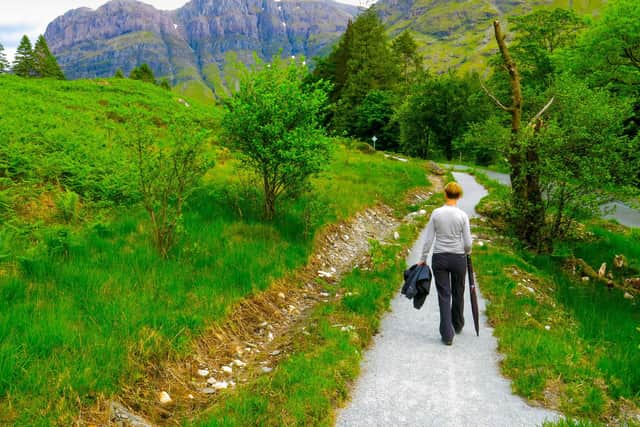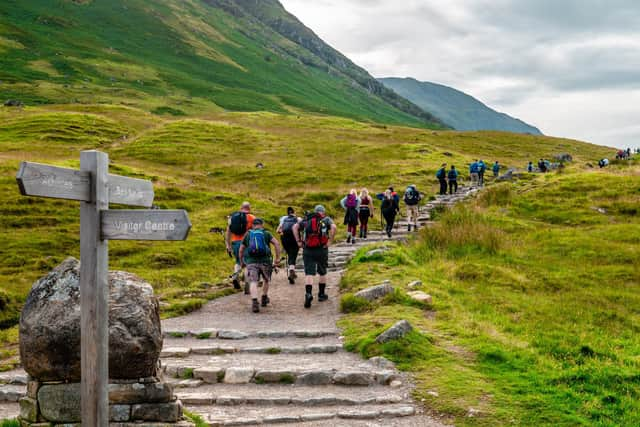What are the right to roam rules in Scotland? Where can I go walking and camping? Can I take my dog?
What is the right to roam?
The “right to roam”, which is shorthand for the general public right of access introduced in The Land Reform (Scotland) Act 2003, allows members of the public to access most land and inland water in Scotland for recreational or other purposes provided the right is exercised responsibly.
It was introduced to strike a balance between a person's freedom to roam and respect for private property.


Advertisement
Hide AdAdvertisement
Hide AdThe right allows the general public to be on, or cross, land for:
▪ recreational purposes, which ranges from camping to picnicking;
▪ carrying out relevant educational activities; and
▪ limited types of commercial activities.


Prior to 2003, access rights for recreational purposes had been exercised largely through the tolerance of landowners, rather than as a right, unless a public right of way had been established.
Some limited statutory rights were created in 1967, but there was considerable confusion about the extent of access rights and the rights of different parties.
Are there restrictions under the right to roam?
Yes. The law sets boundaries on the extent of the right so that the benefits of private ownership are still respected. Thus, for example, the “right to roam” will not extend to include land that is adjacent to dwelling houses, farm buildings, compounds, schools, and the like.
It does not apply to domestic gardens. There isn’t a set distance, but if you think you are too close to someone’s window, you probably are. Both of these exceptions are to allow people to upkeep a certain degree of privacy.
What about dog walking?
In Scotland, you can walk your dog on most land as long as you follow the Scottish Outdoor Access Code (see below for details) and keep your dog “under proper control”.
The law does not, however, state dogs must be kept on lead. This is a cause of concern for farmers who face sheep worrying incidents year on year with some out-of-control dogs running through fields livestock. During lambing season, this can be catastrophic for farmers.
Advertisement
Hide AdAdvertisement
Hide AdSome farmers have called for the right to roam to be revised to reflect the increase in dog walkers in the countryside.
For dog walkers, the Code says:
Never let your dog worry or attack farm animals
Don't take your dog into fields where there are lambs, calves or other young farm animals
If you go into a field of farm animals, keep your dog(s) on a short lead or close at heel and keep as far as possible from the animals
If cattle react aggressively and move towards you, keep calm, let the dog go and take the shortest, safest route out of the field
Don't take your dog into fields of vegetables or fruit unless there is a clear path, such as a core path or right of way, and keep your dog to the path
During the ground nesting bird breeding season (usually April to July) keep your dog on a short lead or close at heel in areas such as moorland, forests, grasslands, loch shores and the sea shore to avoid disturbing birds that nest on or near the ground
Avoid causing concern to others by keeping your dog close at heel or on a short lead
Pick up and remove your dog's faeces if it defecates in a public open place
What are the landowners’ responsibilities when it comes to right to roam?
Advertisement
Hide AdAdvertisement
Hide AdLandowners have an obligation to ensure others are able to exercise public access rights over the land they own.
They must use and manage their land in a responsible way, having regard to the rights of the public
Does the right to roam apply to driving?
No. Access rights don’t extend to caravans or cars.
Motorised activities like off-road driving do not fall under the right to roam and require the land owner's permission. Drivers should check for local rules about parking for vehicles, for example, there are bylaws at Loch Lomond and the Trossachs National Park.
If there are no such rules in place, drivers should take care to park up safely on roadsides to ensure other traffic can pass.
Where does the Scottish Outdoor Access Code fit in?
The Scottish Outdoor Access Code is a set of guidelines to follow when out and about to help ensure a person is accessing land in Scotland responsibly in accordance with the Land Reform (Scotland) 2003.
It outlines some basic common-sense principles, such as making sure a person is responsible for their own actions, that they respect other people’s privacy and peace of mind, and they are taking care to not harm the environment.
The code also gives guidance to land managers in relation to land where access rights apply.
Malcolm Combe, author of The Scotways Guide to the Law of Access to Land in Scotland, has previously compared the Code to the Highway Code – there is traffic legislation, but the Highway Code provides guiding principles that are “very influential and persuasive”, but don’t quite have the same legal status as a speed limit, for example.
What are the rules in England?
Advertisement
Hide AdAdvertisement
Hide AdThe rules are different in England, where the right to roam only applies to “open access land”.
However, even in these areas a person cannot usually camp, cycle, drive or horse ride.
This means that camping is largely restricted to campsites, whereas in Scotland wild camping is possible in areas.
The Labour party has pledged to introduce a Scottish-style right to roam law in England if it wins the next general election, with access to green space enshrined in law.
Comments
Want to join the conversation? Please or to comment on this article.
